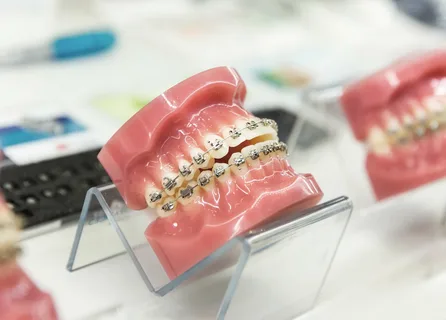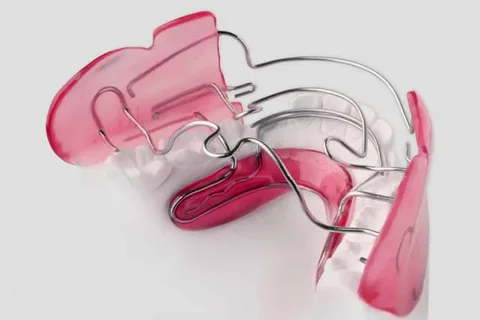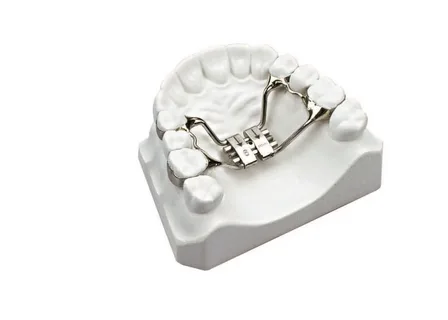General characteristics of orthodontic appliances
Machine translation
Original article is written in RU language (link to read it).
Orthodontic treatment is a combination of various therapeutic and preventive measures, these include the following:
myogymnastics,
use of special devices,
prosthetics,
surgical interventions,
combined treatment.
Learn more about the treatment of distal occlusion in the online course Distal occlusion: treatment of growing and non-growing patients .
Hardware method
The hardware method involves the use of special orthodontic devices - devices that are necessary directly to correct the bite.

Figure 1. Variety of orthodontic appliances.
To date, many models of various orthodontic appliances have been developed, which in turn are divided into three large categories:
preventive,
medicinal,
retention.
Representatives of the first group - prophylactic devices - serve to prevent the development of dentoalveolar deformations and anomalies, which can occur if a child has bad habits, mouth breathing, incorrect habitual position of the tongue, or due to early removal of teeth, both temporary and permanent. These devices are removable and non-removable.
Representatives of the second group are retention devices, also called retention devices, used to consolidate the positive results of the treatment, as well as to prevent relapses. The need for their use is due to the slow rate of histological restructuring compared to anatomical transformations, which are achieved quite quickly with the right treatment method. There are removable and non-removable retention devices.
The last group, the group of medical devices, is the most numerous. It is the representatives of this group that are the very orthodontic devices that can eliminate the bite deformities that have formed in the patient for one reason or another. Their action is based on the application of traction and pressure.
The design of a therapeutic orthodontic apparatus is based on a rational combination of functional, active and support-retaining devices. The combination of design elements is determined by the purpose of treatment and clinical and laboratory equipment.

Figure 2. Bracket system.
Orthodontic treatment usually involves the movement of one tooth or several teeth at once, and it can occur in one or several directions simultaneously (transversal, vertical, sagittal).
In severe clinical situations, the orthodontist is faced with the task of moving the entire dentition on one of the jaws. Severe forms of malocclusion require the use of several orthodontic appliances, the effects of which are different, since there are no universal designs suitable for any age, and the initially manufactured appliance becomes unsuitable.
According to the principle of operation, all orthodontic treatment devices are divided into groups:
Mechanically acting structures are a set of devices, the action of which is determined by the elasticity of their constituent components. Their action is due to the work of an orthodontic wire, screw, rubber ring or ligature. These devices are active because they have their own source of power. The orthodontist can only adjust the intensity and strength of the load. The most popular and widely known representative of this group is the multibonding system.
Functional guiding devices are a set of devices where the main source of force is the contraction of the patient’s own masticatory muscles; this force is directed to the teeth that are to be displaced by means of occlusal pads, inclined planes and bite pads. The operation of the apparatus with such structural elements is based on the fact that the force of chewing pressure is concentrated in the area of one or more teeth that need to be moved in a given direction. Disconnecting plates, which include occlusal pads and bite pads, ensure active growth of the entire jaw or certain areas, and also allow teeth that are in this position to be removed from the block as a result of pathology in the development of the jaw. These devices are capable of transmitting chewing pressure vertically to specific teeth, thereby ensuring alignment along the occlusal plane of the dentition.
Functionally operating devices are a set of devices called regulators or activators. The designs of these devices are equipped with arches, lip pads, base plates, and cheek shields. The use of these structures is aimed at correcting the position of the lower jaw, activating or slowing down the growth of the jaw bones as a whole or some of its parts, and regulating the effect of muscle groups on the dentition.
Combined devices are designs that combine elements of the first and second or first and third groups.
To achieve movement of one tooth, several teeth or to influence the development of the entire jaw, sufficient force and adequate support are required.

Figure 3. Orthodontic treatment.
Devices of the first group use the power of active structural devices that are included in their composition: arcs, springs, screws, rubber rings, ligatures.
Among the representatives of the second group of devices, the source of force is the own chewing muscles.
Representatives of the third group provide reorganization of functions: breathing, speech formation, swallowing, chewing, promote the onset of myodynamic balance of the dental system, and help achieve conditions suitable for jaw development.
In addition to the active force that is transmitted to the displaced teeth, there is also a reaction or recoil force, also called reactive force. These forces, active and reactive, can work unidirectionally or multidirectionally, within a specific jaw, or on different jaws.
The mobile part is the part of the apparatus that is directly involved in the movement of the teeth, and the supporting-fixing part is the stationary part of the orthodontic structure. According to Newton's law, these forces are equal, hence the importance of the support selection stage when planning treatment.

Figure 4. Orthodontic appliance.
What is support in orthodontics?
Support is a quantity that is oppositely directed to the force moving the tooth. There are two types of support in orthodontics: reciprocal, or interacting, and stationary.
Reciprocal support involves the use of counter force to improve the fixation of the entire structure and the movement of teeth.
The stationary support is based on the immobility of the fixing part of the structure; it does not participate in the movement of teeth. By increasing the area of support, the counterforce that falls on any of the supporting teeth decreases, this guarantees the stability of their position.
Concept of force in orthodontics
The direction of the acting force in clinical orthodontic practice is difficult to calculate, and it is important to take into account many factors:
patient's age,
period of root formation,
hemodynamic features in different parts of the dental system.
The use of weak forces in orthodontic practice is considered the most appropriate.
The amount of force applied should not have a negative effect on hemodynamics in the area of periodontal pressure. The load is determined by the group affiliation of the tooth being affected, the direction of the active force, and depends on the choice of support and the type of materials used.

Figure 5. Manufacturing of an orthodontic appliance.
Classification of force in orthodontics
continuous - valid for a certain time between doctor’s appointments;
interruptible - the strength between activations drops to zero;
intermittent - the force abruptly drops to zero when the patient removes the orthodontic appliance.
To move teeth, it is important to observe the following conditions:
magnitude of force;
direction of force;
choice of support;
availability of space for tooth movement within the dentition;
reliable fixation of the device;
taking into account the general condition of the child;
taking into account the individual anatomical and functional characteristics of the maxillofacial zone.
Moving teeth
There are two types of movement:
Corpus – aimed at simultaneously displacing the crown and root of the tooth by the same distance in one direction.
Oblique-rotational involves the displacement of the crown and root differently when the magnitude of the displacement force is different for the root and crown.
Analysis of extraction methods of orthodontic treatment, selection strategies and clinical cases in the online course Treatment with extraction: aligners and braces .

